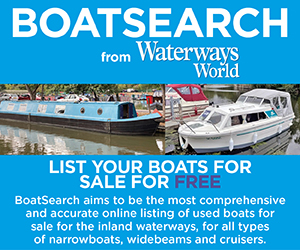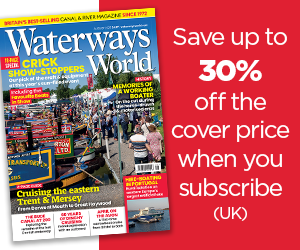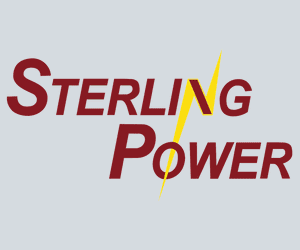Profiles: Company Profiles
Water Freedom
Water, water everywhere
Liveaboard boater Tony Jones checks out a game-changing new product that could mark the end of many boaters’ water issues and be a major selling point for boat-builders.
Life afloat requires a lot of plate spinning. If we’re not worrying about when our toilet needs emptying, we’re fussing about how much power we’re using and how we’ll replenish it. But it might surprise you that, for many boaters, the most frustrating limiting factor is water. Depending on the size of the water tank, how many people use it and how much time they spend aboard, a typical water tank could need refilling anywhere between every four to 14 days.
It’s at least a mildly ironic part of living aboard, considering we’re literally surrounded by water. Sadly, the H2O found in our canals and rivers is too contaminated to be of any use, least of all for drinking – until now. While scanning the stands at this year’s Crick Boat Show, one company in particular caught my eye. Water Freedom claims to offer a solution to boaters’ water consumption and refilling issues by filtering canal or river water for use aboard the boat. It’s a bold claim and, if true, it could revolutionise liveaboard boating forever – not to mention become an attractive selling point for new boats. John Howard is the company’s founder and he had an interesting, if somewhat familiar, story to tell.

The mother of all invention
“Back in early 2015 we’d been living on a narrowboat for a couple of years with a water tank just big enough to last a couple of weeks if we were really careful, but with our two daughters rapidly approaching their teens, my wife and I were painfully aware that we needed more space, so we ordered a 60ft x 12ft wide-beam. “While our new boat was being built, with four of us going to be living aboard full time, we knew the size of the water tank would be critical. I kept asking the boat-builder how big the water tank would be, hoping to get an answer in litres so that I could work out how long it would likely last between refills, but the only response I could get was, ‘Huge, don’t worry about it!’ Of course, I did worry, and when the boat arrived, I was pretty annoyed to discover that the tank was just 450 litres and would likely last only a few days with the girls on board. It was an issue that became a significant problem as soon as I finished the fit-out and we moved in.
“At the time we were continuously cruising, mostly in and around London, and navigating all of the usual London-centric challenges of finding vacant moorings and filling up with water. One day, as we approached the water point in Little Venice, I saw a boat leaving Paddington Basin. Such a convenient mooring becoming available just as we turned up was too good to be true but there was a snag. I knew we were running low on water and should really fill up before we tied up, but if I did so we’d probably lose that spot. I had to think fast, so I decided to claim the mooring and worry about the water situation later.
“By lunchtime the next day we were having to severely ration our water use, but I knew that if I went to fill up, our mooring would be taken when we got back. In the end, I waited until 3am that night to sneak off to the tap. As I stood there in the dark, waiting for the painfully slow flow of water to fill the tank and hoping our mooring spot would still be there, I got to thinking that there must be a way to use the water that was all around us. One thing I did know for sure was that we couldn’t continue to live aboard as we were. That’s when I started experimenting.”
The technology
In 2016, after a year of R&D and successfully testing the system aboard his own boat, John launched the Water Freedom product onto the market. The system works by drawing water from the canal or river, using a high-pressure pump to force the water through a series of filters to remove sediments, hydrocarbons, pesticides, heavy metals and a number of other contaminants. The water then passes through an ultraviolet steriliser to kill bacteria, viruses and cysts. The system produces 10 litres of water per minute, although the company’s optional up-rated version almost doubles that. That means a 400-litre tank would take between 20 and 40 minutes to fill, depending on which system you choose.
The main contaminant the filters deal with is sediment, those tiny particles that muddy the water in the cut, but these are relatively easy to remove. The next challenge is chemical, specifically the oil and diesel we see so often on our canals and rivers. Then the focus moves to neutralising pathogens such as bacteria and viruses to produce water which is suitable for bathing, laundry and pot washing.

But can you drink it?
The company has always advised customers not to drink the water from the main system without additional purification. “We’re not just covering our backs when we say this, we’re genuinely concerned about our customers’ long-term health,” explains John. “While the water produced by the main system is incredibly clean, what we’ve always struggled to get out of the water are nitrates and nitrites, mostly fertiliser run-off from farmland. Then there’s the problem that a boat’s water tank is far from being a sterile environment, so no matter how the clean the water is that goes into the tank, who knows what might be growing in there? So the pathogen risk is always present – and that goes for anyone living on a boat, not just Water Freedom customers.”
The good news is that Water Freedom has recently developed a peripheral unit which, along with other processes, uses reverse osmosis to create drinking water that the company claims is cleaner than mains tap water anywhere in the world. Around the size of a desktop PC’s hard-drive tower, the Water Freedom Pure unit gets installed under the kitchen sink, acting as a final defence against even the smallest of pathogens, as well as removing almost all remaining chemical residues, including those hard-to-remove nitrate and nitrite fertilisers.
I was eager to find out more about that ‘cleaner than tap water’ statement. “The laboratory we use to test our water samples also works for many of the major water companies,” explained John. “The Pure system tests came back showing zero or near zero results for all of the contaminants the lab tested for. And those test results that didn’t read zero were because the report had to show the smallest measurement their equipment could detect. The lab technician we spoke to was astonished by what we’d been able to get out of canal water. It’s about as close to pure H2O as you can get.”
Speaking with technical director, Matt Booth, about the performance targets that were set for the Pure system, Matt explained, “We knew that we had to not only make the water drinkable, but it also needed to be safe throughout the entire life of the filters. It had to be just as pure at the end of the filter’s life as it was at the beginning.”
Matt was also keen to stress that another key product goal was that the Pure system had to be ‘easy to live with’ in terms of the noise created by the unit, the taste of the water and the rate of flow throughout the life of the filter. “A lot of RO systems only produce around 0.1 litres per minute, meaning that they run almost constantly and need an accumulator tank. You’ll get at least 1.8 litres of water from the Pure system, and even more when the filters are new, meaning that it doesn’t need an accumulator and only needs to run for the short time it takes to fill your glass or saucepan.”
Plan B
Some boaters with one of Water Freedom’s tank-filling systems fitted use a ZeroWater filter jug to remove any remaining contaminants and dissolved solids that may have made it through the filtration process to make the water drinkable.
Power usage
The standard Water Freedom system draws about 300 Watts at 240 volts, with the up-rated UltraMegaFlow system drawing roughly double that, but as it produces twice the amount of water as the standard system, the total power consumption is about the same for any given litre of water.
However, the system doesn’t need to run for very long, usually only 20 minutes at a time, maybe two or three times a week. Boaters with a decent solar system should find it runs perfectly well just using solar on a decently sunny day. On dull days you might need to run the engine or generator while you’re running the pump. You’ll also need to switch on your inverter because the system needs a 240-volt power supply.
The cost
The basic filtration and UV Water Freedom system costs around £3,000 to purchase and install, with upgrade options such as electronic touch-button filling and touchscreen displays adding to the cost incrementally. There’s even a portable system available for boaters who do not have space aboard to retrofit the system. Installing the Pure under-sink unit to provide drinking water will cost up to £1,200, although it’s slightly cheaper if you have it fitted at the same time as the main filtration and UV system. And of course, there is a profit to be had by boat-builders and engineers who choose to sell and fit the Water Freedom system.
Admittedly this sounds like a decent chunk of money for customers to stump up and I was curious to find out if there were cheaper suppliers offering similar products. “Similar, but not at all up to the same standard,” explained John. “We’ve seen dubious UV sterilisation systems that are either under-spec, not installed properly or both, as well as dangerous set-ups that pose significant electrical risks in terms of a potentially lethal electrical shock for the user and a very real fire risk. We’ve also seen systems that are plumbed in in such a way that directly feed the taps. While this might sound like a good idea, it could sink your boat should your plumbing spring a leak. Instead of just your water tank emptying into the bilges of your boat, the system would keep pumping water from the canal until your boat fills up and sinks. It’s a pretty bad idea.”
Saltwater
The Water Freedom system doesn’t work on brackish or saltwater sources, although the company is aiming to release a desalinating version soon.

Conclusion
To my mind, the ability to turn canal water into an unlimited source of water for showers and washing the dishes is a game-changer for all boaters, and especially continuously cruising liveaboards. And being able to then take that a step further and turn it into drinking water that’s cleaner than regular tap water is just mind-blowing. The idea of finding a great mooring and being able to settle in for a two-week stay will be a dream come true for many. The product also negates many of the frustrations caused by an off-grid water supply system. Imagine no more queuing for taps or standing around waiting for a super-slow supply to fill your tank, and the frustration of finding taps out of order or frozen solid during the winter would be a thing of the past too.
Then there’s the opportunity to enjoy a more luxurious lifestyle, where washing machines and dishwashers are a viable option, not to mention having worry-free longer showers. My eco-friendly wife is also keen to point out the environmental benefits of not relying on the commercial water-companies’ infrastructure, and not burning diesel for hours on end as you cruise to find the nearest water point. John is quick to point out that the Water Freedom system does rely on an amount of plastic in its construction, but adds that the company does try to be as environmentally sensitive as possible in its manufacturing processes. My guess, though, is that even accounting for the use of plastics, the product is still a major net-force for the environmental good.
All told, I think Water Freedom has solved one of boating’s biggest frustrations with a relatively affordable price point. Liveaboard boaters in high-density areas such as London will probably just form a queue, but the system seems to provide additional convenience for all boaters. And convenience is something that’s well worth paying for in the minds of many boaters today. John tells me that the Water Freedom system is already on the options list at several boat-building companies, with most recommending the high-spec units for the ultimate modern-boating luxury experience. In my mind it’s another step toward ironing out the disparities between boat life and a traditional bricks-and-mortar home. Water supply issues were once a major frustration for boaters, but with Water Freedom the problem goes away, making boat life an even more attractive and saleable lifestyle. It’s a great opportunity for savvy boat-builders to gain the edge over the competition and create another satisfied customer.
Find out more
Water Freedom
0207 183 1230
waterfreedom.co.uk



